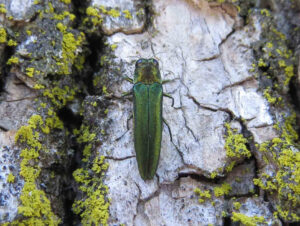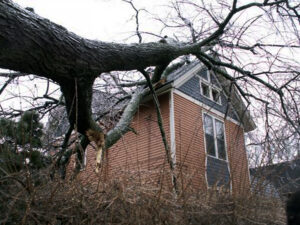
An adult emerald ash borer beetle on a tree trunk. The invasive insect is expected to eventually kill 99 percent of ash trees in Wisconsin. / Photo Credit: Bill McNee, Wisconsin DNR
By Art Kabelowsky, DNR Forest Health Outreach/Communications
Arthur.Kabelowsky@wisconsin.gov or 608-335-0167
Entomology Today magazine has published an article debunking common misconceptions about management of emerald ash borer (EAB). The information in the article can be helpful to communities and landowners deciding whether to invest in treatment to preserve ash trees.
The article focuses on treatments for high-value trees, not those in woodlands. The advice in the summary is clear for communities, property managers of high-use recreational lands and homeowners with ash near residences:
“Allowing nature to take its course is a budget-busting option.”

Ash trees killed by emerald ash borer can prove costly if allowed to stand while dead, eventually falling and potentially hurting people and damaging property. / Photo Credit: John Hieftje
The article by Purdue University entomology professor Cliff Sadof summarizes a longer report, which is linked for those seeking more detail.
The goal of the report is to address common misunderstandings and misinformation which often have resulted in postponement of treatments that could preserve the value of their trees and avoid needless expense, injury and damage.
The summary can help foresters and property managers convince community leaders of the value in proactive planning and treatment in managing the damage EAB does to service providing ash trees.
City of Madison forester Ian Brown found it useful in reinforcing support for the city’s EAB management plan, forwarding it to his forestry teams and partners in the Mayor’s office.
If you work with communities or recreational properties dealing with EAB for the first time, consider sharing the article to encourage timely action.

Emerald ash borer larvae carve channels in the inner bark and sapwood of a tree, almost always resulting in the tree’s death. / Photo Credit: Bill McNee, Wisconsin DNR
